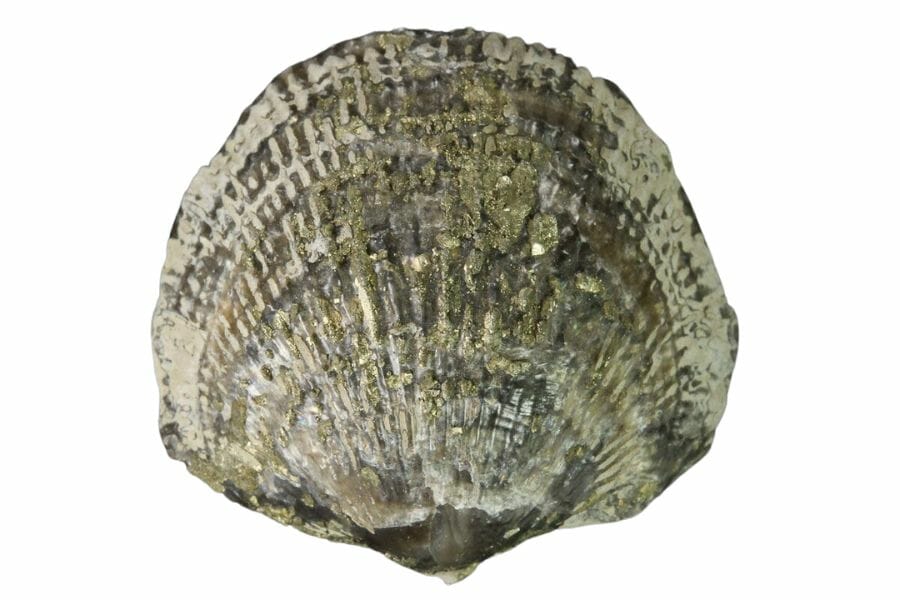Wisconsin is a fascinating state with a rich geological history. The land tells stories of a time long ago, captured in the form of Wisconsin fossils. From trilobites to coral, there’s a great variety of fossils found in this state but they aren’t always easy to find.
This state has been home to seas, swamps, and vast landscapes, each leaving behind a special mark. Fossils are these amazing marks that nature has saved for us.
Many spots across Wisconsin are great for finding fossils. With the right tools, a bit of patience, and lots of curiosity, you can uncover the mysteries hidden beneath the Wisconsin ground!
The Fossils Of Wisconsin You Can Find
Wisconsin’s landscape holds many stories from the past, especially in its rocks and sediments. Digging a little deeper, or sometimes just looking at the ground, might surprise you with traces of life from millions of years ago.
While fossils give a sneak peek into this past world, there’s so much more beneath the surface.
For those keen to uncover more about the state’s geological history, our Wisconsin rockhounding guide offers insights into finding not just fossils but also various rocks, minerals, and gems.
- The extensive local experience and understanding of our team
- Input from multiple local fossil hunters and fossil groups
- The accessibility of the various locations
- Safety and potential hazards when collecting
- Private and public locations
- A desire to include locations for both experienced fossil lovers and those who are just starting out
Using these weights we think we’ve put together the best list out there for those who love finding great new fossils for our collections!
Common Wisconsin Fossils
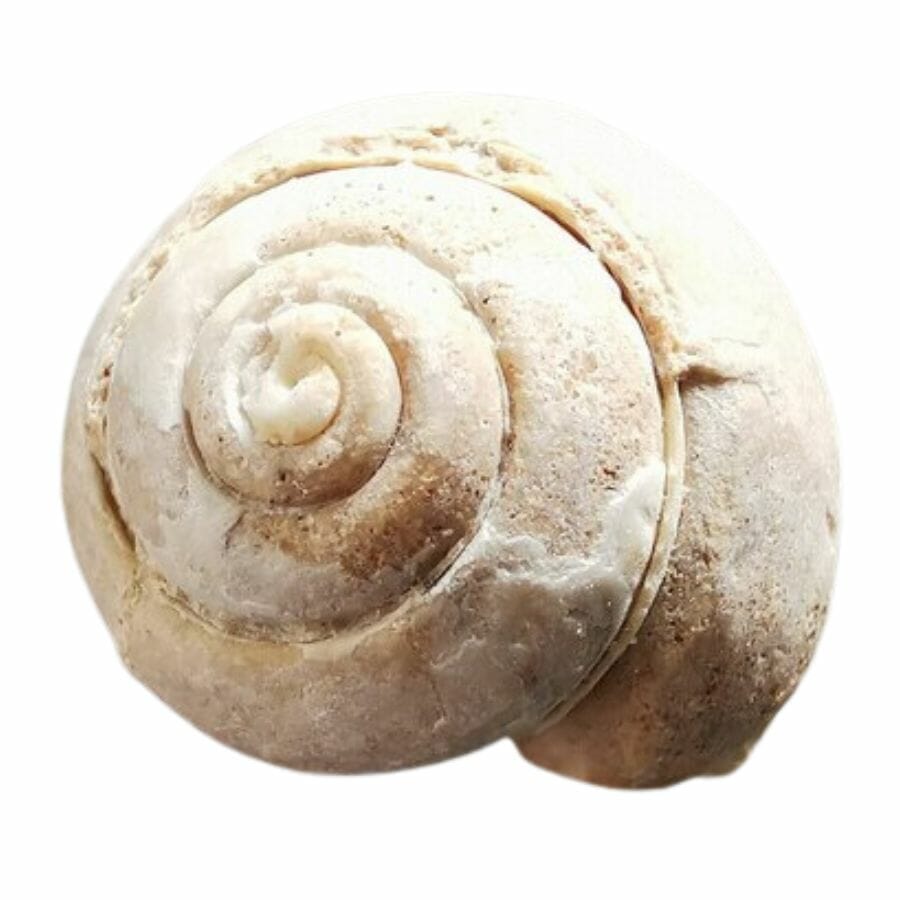
Fossil hunting in Wisconsin is an adventure into the past. As you dig and explore, you’ll come across clues of plants and animals from long ago. Here’s a list of some common fossils you might encounter in the state:
- Trilobites
- Brachiopods
- Corals
- Stromatolites
- Bivalves
- Gastropods
- Cephalopods (squid and octopus)
- Trace fossils
- Crinoids
- Bryozoa
Wisconsin State Fossil – Calymene celebra trilobite
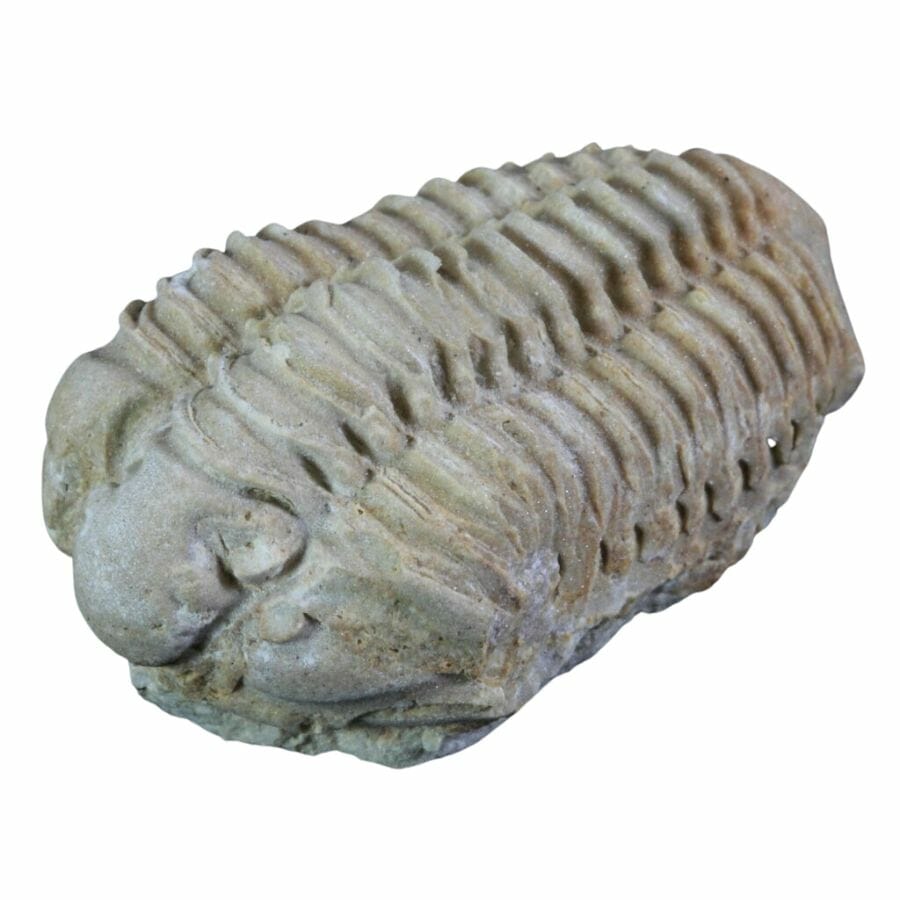
The Calymene celebra trilobite is a cool fossil from a long time ago. Trilobites were sea creatures that looked a bit like modern bugs, but they lived underwater.
This type of trilobite has a unique shape with a rounded body and lots of tiny ridges. They once roamed the ocean floors, and now we can find their remains as fossils.
These critters lived in our oceans long before dinosaurs walked the Earth, specifically during the Silurian Period. Their unique, three-lobed and oval-shaped body design helps in easy identification.
Rare Wisconsin Fossils
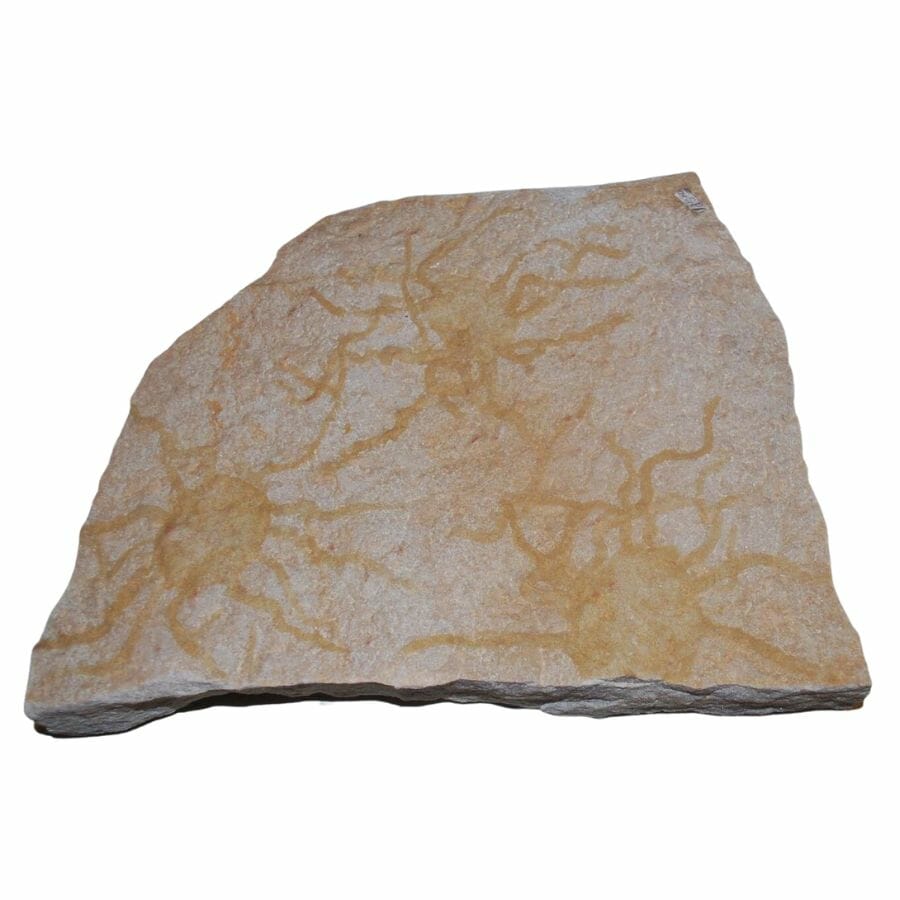
In addition to common finds, here are some valuable rare Wisconsin fossils that you might come across:
- Jellyfish fossils
- Fossilized soft tissue
The Best Places To Find Fossils In Wisconsin
Wisconsin has many spots where curious explorers can uncover traces of creatures from long ago. If you’re eager to start your fossil journey, knowing the best places to search is key!
Always Confirm Access and Collection Rules!
Before heading out to any of the locations on our list you need to confirm access requirements and collection rules for both public and private locations directly with the location. We haven’t personally verified every location and the access requirements and collection rules often change without notice.
Many of the locations we mention will not allow collecting but are still great places for those who love to find beautiful rocks and minerals in the wild without keeping them. We also can’t guarantee you will find anything in these locations since they are constantly changing.
Always get updated information directly from the source ahead of time to ensure responsible rockhounding. If you want even more current options it’s always a good idea to contact local rock and mineral clubs and groups
Newport State Park
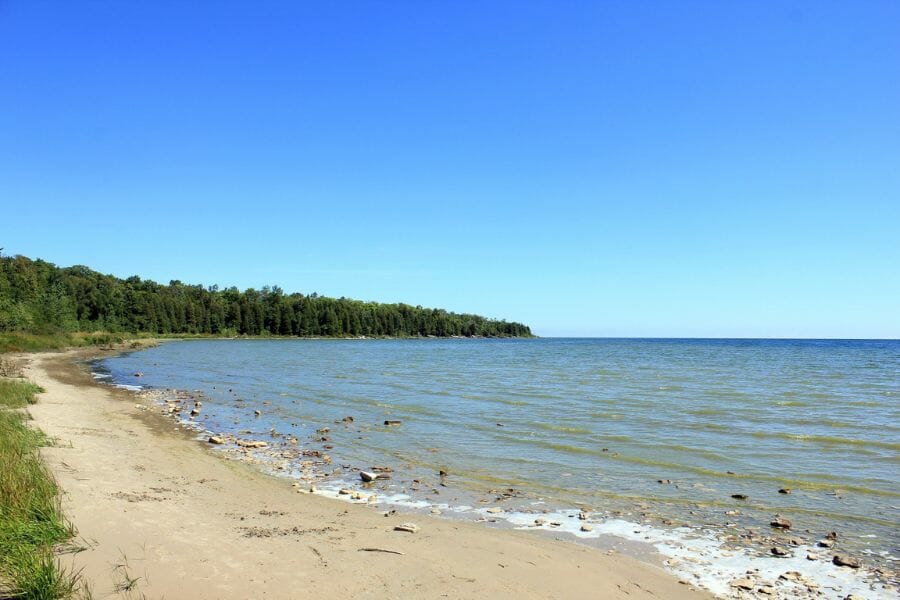
Newport State Park is a vast and beautiful area, offering a mix of dense forests and rugged Lake Michigan shoreline. The park sprawls over 2,373 acres, showcasing diverse terrain from pebbly beaches to rocky cliffs and dense woods.
As for its geology, the rocks here hold secrets from millions of years ago, making it a prime spot for enthusiasts seeking the fossils of Wisconsin.
Newport State Park is accessible by car, and once you arrive, there are well-marked trails and paths to guide your adventure. Whether you’re there to explore its geology, hike through the woods, or just enjoy the scenic views, this park offers a little something for everyone.
Where to find fossils in Newport State Park
In the rocky cliff areas and pebbly beaches, you’ll find imprints of plants and animals that once thrived in this region. So, when you’re exploring the trails or taking a stroll along the beach, keep an eye out for opportunities to find fossils.
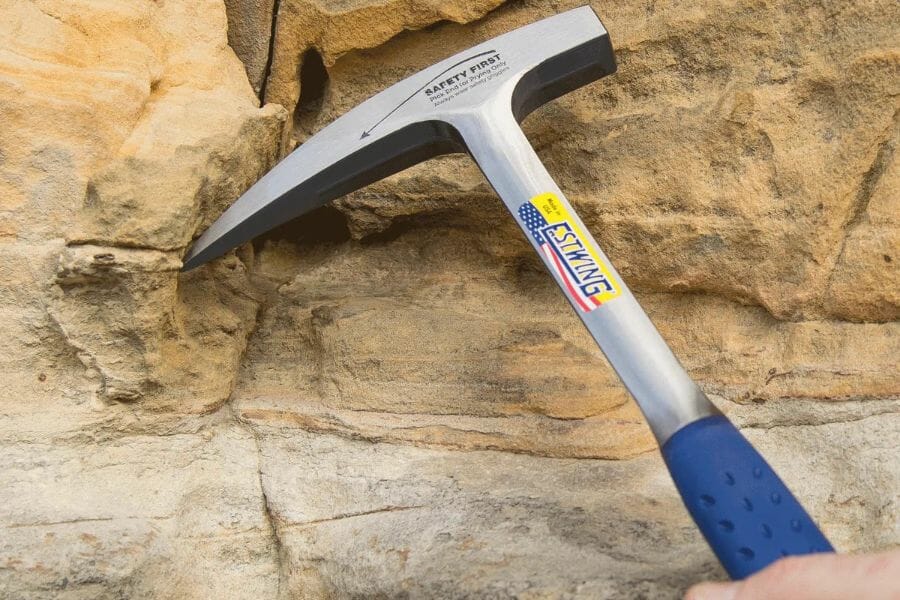
The tools every fossil hunter will need
When you're out looking for fossils having the right tools for the job is really going to make or break your success. You don't need a lot for most trips but there are a handful that are critical and will make your life a lot easier.
We get asked a lot about the equipment we use. Over the years we've found a handful of tools that we recommend to both new and experienced fossil hunters which we outline in great detail in our complete rockhounding tools and kit guide. These are quality options that also happen to be relatively inexpensive.
Below are the basic tools that make your life so much easier and save you a ton of time. Check out the full guide to see everything we recommend bringing. One quick note, as an Amazon Associate I earn from qualifying purchases but we try very hard to only recommend gear we would use ourselves and often recommend brands you can't find on Amazon.
At a minimum you should have:
1 - Sturdy rock hammer: The Estwing Rock Pick is our standard
2 - Rugged chisels: Try Kendo' 3-piece Chisel Set
3 - Compact shovel: The Koleiya 28-inch shovel works well
4 - Rock screen pan: The Wazakura Soil Sieve Set fits the bill
5 - Eye protection: DeWalt Safety Glasses are cheap and comfortable
6 - Head protection: Malta's Safety Helmet has been our go-to
7 - Jewelers lens with at least 20x magnification: Jarlink's Jewelers Loop is perfect
The fossil-finding books that we use most
There are also a few books that have been extremely helpful in the search for gems. These books have great recommendations and tips:
National Audubon Society Field Guide to Rocks and Minerals: North America
Northeast Treasure Hunter's Gem & Mineral Guide
Earth Treasures: The Northeastern Quadrant
We provide links to find these tools on Amazon but some can also be found at your local hardware stores. For more recommendations check out the link to our full tool guide above.
Cave of the Mounds
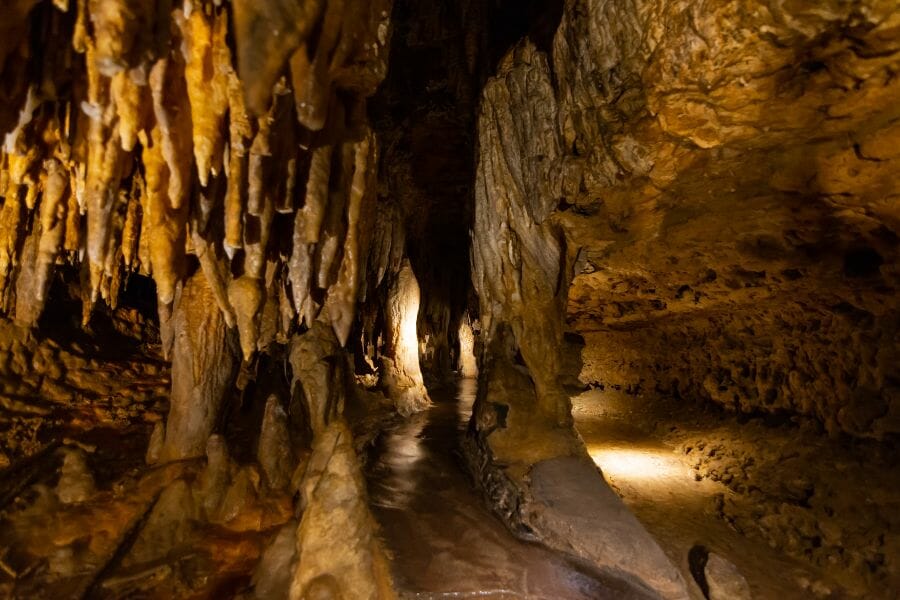
Cave of the Mounds is a fascinating underground cave that showcases stunning rock formations like stalagmites, stalactites, and sparkling crystal formations.
Among the captivating geological wonders, some visitors even get a chance to spot evidence of fossils in Wisconsin.
The terrain around the cave is hilly and lush with vegetation, offering scenic views before you even step underground. Inside, well-lit pathways guide visitors through chambers that unveil the beauty formed over countless years.
The cave’s temperature remains cool throughout the year, making it a refreshing destination during warmer months.
Cave of the Mounds is pretty accessible by major roads, and there’s ample parking for visitors.
Where to find fossils in Cave of the Mounds
As you venture through the cave, you’ll come across imprints of marine animals and plants that once thrived in prehistoric seas. The best spots to observe these fossils are along the cave’s corridors and in some of its spacious chambers.
Waukesha
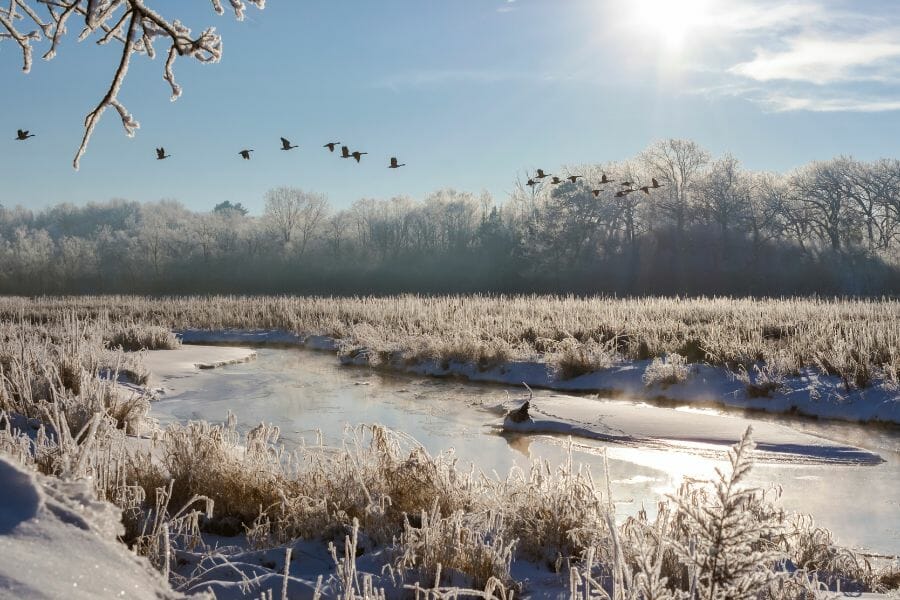
Waukesha boasts a rich tapestry of varied terrains from rolling hills to meandering rivers. It’s known for its unique geology, which tells stories from millions of years ago.
This area is famous for its valuable rare Wisconsin fossils, including some extraordinary finds. Notably, soft tissue fossils, which are uncommon due to their delicate nature, have been unearthed here.
The geology of the region offers layers upon layers of sedimentary rock, showcasing epochs of Earth’s history.
If you’re eager to visit, you’ll be pleased to know that Waukesha has well-connected roads and transportation options.
Where to find fossils in Waukesha
Within the city’s limestone quarries, one can uncover remnants of marine creatures that lived in prehistoric seas. These fossils, often seen as imprints or full formations, are found mainly in the layered rock walls of these quarries.
Lake Michigan
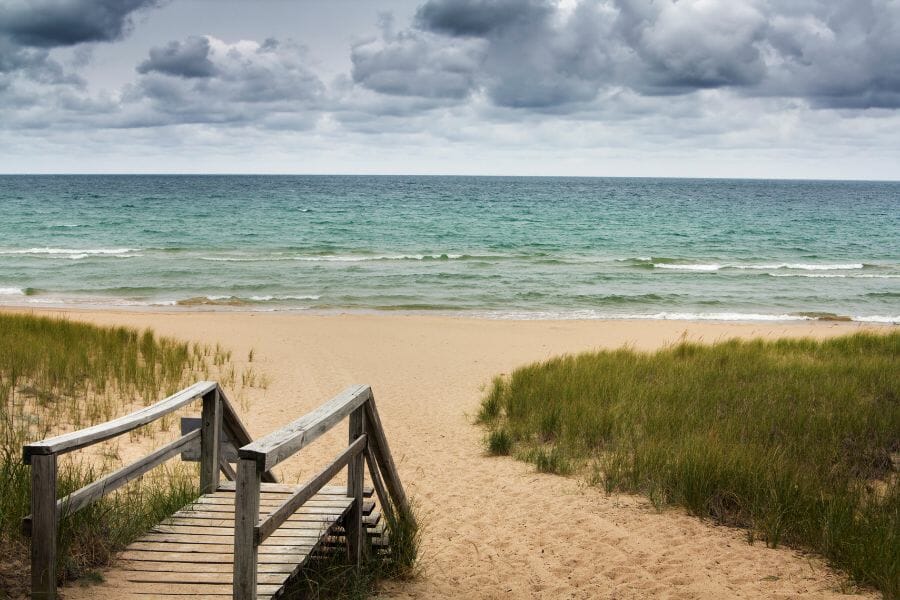
Lake Michigan is one of the five Great Lakes and holds a special place in many hearts. It’s vast, with shimmering waters that stretch far and wide, touching multiple states along its shoreline.
The terrain around the lake varies, from sandy beaches to rocky cliffs, offering a diverse landscape for all nature lovers.
The geology here is fascinating; the lake’s shores and nearby areas have rocks and formations that reveal clues about the creatures and plants that once thrived in the region.
Reaching Lake Michigan is simple. Many roads lead to its beautiful shores, making it a popular destination for families, friends, and solo travelers.
Where to find fossils in Lake Michigan
Along the sandy beaches and rocky outcrops, enthusiasts often uncover various marine fossils. These include fossils of corals, trilobites, and crinoids embedded in the stones and pebbles.
Eau Claire River
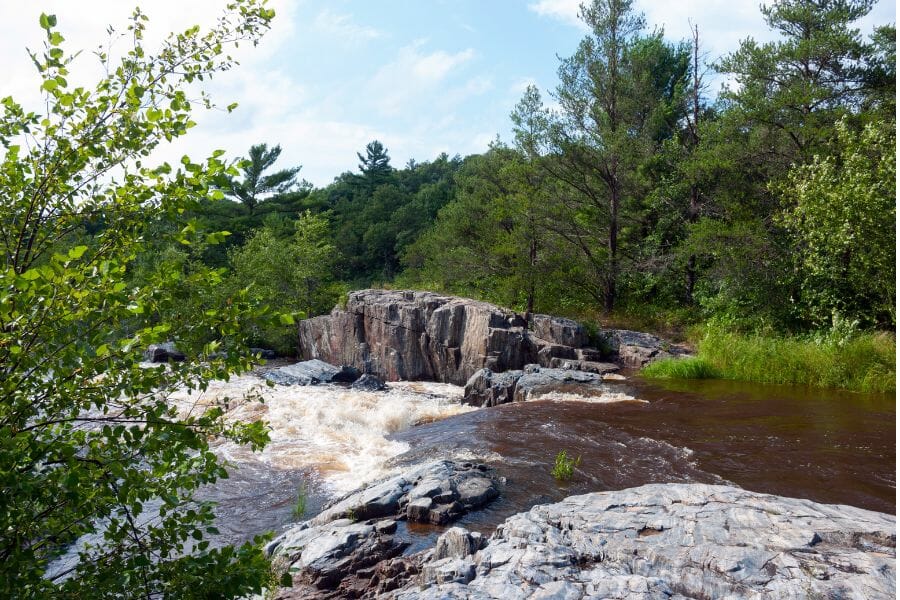
The Eau Claire River flows gracefully through picturesque landscapes, offering both scenic beauty and a window into the planet’s past. Originating from clear springs, the river snakes its way, carving out valleys and shaping the land.
As it meanders, the river reveals layers upon layers of various rock formations along its banks.
The terrain surrounding the river varies, with dense forests, gentle hills, and open grasslands. Here and there, you might even spot small waterfalls adding charm to the river’s journey.
For those eager to visit, the river is easily accessible. Numerous trails and parks are dotted along its course, and well-maintained roads lead to popular spots.
Where to find fossils in Eau Claire River
Along its banks, embedded in rock layers, one can discover traces of marine creatures that once inhabited the region. Specifically, you’ll find imprints of corals, brachiopods, and occasionally trilobites.
It’s best to explore the rocky outcrops and exposed bedrock areas, where these fossils often come to the surface.
Other Top Places To Find Wisconsin Fossils By Region
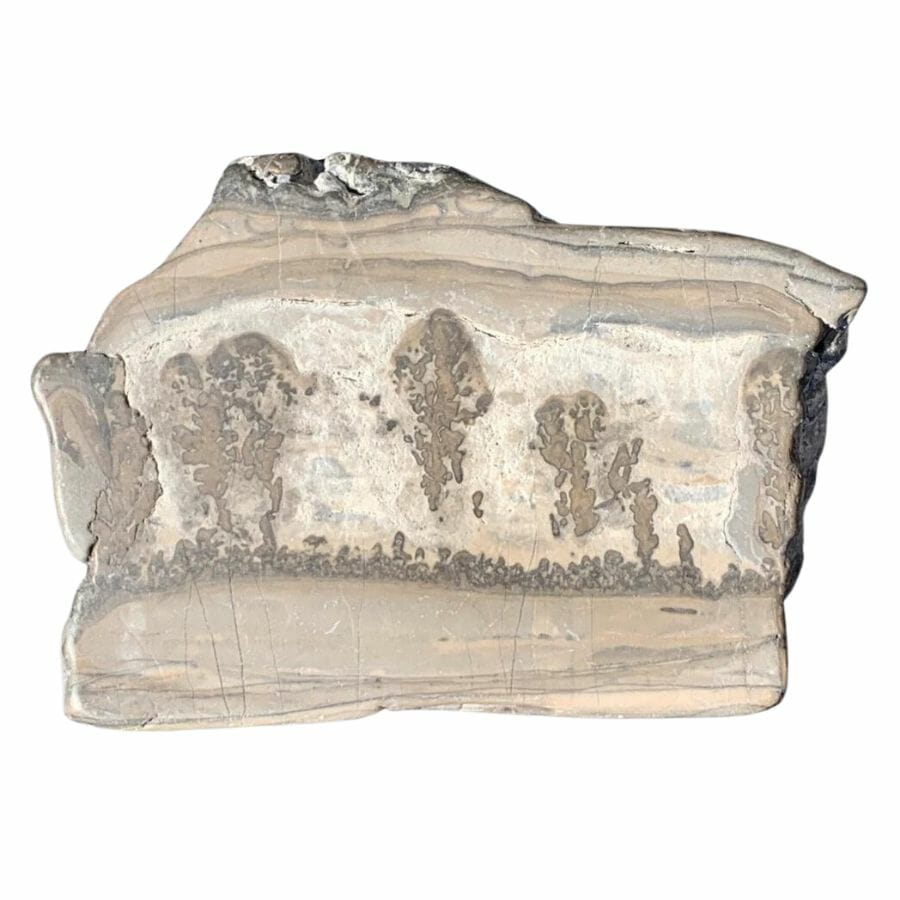
From riverbanks to rocky outcrops, there’s so much to explore in Wisconsin. Here’s a list of areas where you can embark on a fossil-finding adventure!
| Location | Fossils |
| Green Bay, Brown County | Encrinurus, bryozoa |
| Dodge County area exposures | Fusispira, Murchisonia |
| Sturgeon Bay, Door County | Conodonts, Microvertebrates, Loganellia, Valyalepis, Zuegelepis |
| Colfax, Dunn County | Hyolithes |
| Eau Claire, Eau Claire County | Trilobites, brachiopods |
| Ashford, Fond du Lac County | Phragmoceras, Pleurotomaria |
| Dickeyville, Grant County | Brachiopods, sponges, ostracods |
| Fennimore, Grant County | Crinoids |
| Berlin, Green Lake County | Crepicephalus |
| Kingston, Green Lake County | Trilobites, brachiopods |
| New Glarus, Green County | Trilobites, brachiopods, ostracods, gastropods, hyolithes |
| Elroy, Juneau County | Worm tracks |
| Mauston, Juneau County | Brachiopods |
| Wood Hill, Juneau County | Trilobites |
| Carlton, Kewaunee County | Holopea, Murchisonia, Orthoceras, Cyrtoceras |
| Forrestville-Bailey’s Harbor, Kewaunee County | Corals |
| Wauwatosa, Kewaunee County | Strombodes |
| Halfway Creek, La Crosse County | Trace fossils, Lingula, fucoids, brachiopods |
| Stevenstown, La Crosse County | Trace fossils, Lingula, fucoids, brachiopods |
| Reedsville, Manitowoc County | Trilobites, corals, brachiopods, stromatoporoids, bryozoa, crinoids |
| Valders, Manitowoc County | Trilobites, corals, brachiopods, stromatoporoids, bryozoa, crinoids |
| Mosinee, Marathon County | Medusae, Euthycarcinoids, ichnofossils, Protichnites, large jellyfish |
| Brown Deer, Milwaukee County | Spirifer, mollusks, Rhynchodus |
| Milwaukee, Milwaukee County | Trilobites, Dinichthys, Eczematolepis, Gamphacanthus, Heteracanthus, Oestophorus, Ptyctodus, Rhynchodus, Lingula, Discina, Orthis, Stropheodonta, Chonetes, Spirifer, corals, stromatoporoids, brachiopods, bryozoa, mollusks, crinoids |
| Wauwatosa, Milwaukee County | Sponges Ischadites, trilobites |
| Whitefish Bay, Milwaukee County | Lingula, Discina, Orthis, Stropheodonta, Chonetes, Spirifer |
| Tomah, Monroe County | Maustonia, Parabolinoides |
| Tunnel City, Monroe County | Trilobites, brachiopods |
| Cedarburg, Ozaukee County | Trilobites, corals, brachiopods, bryozoa, crinoids |
| Pierce County regional exposures of buff Limestone | Strophomena, large branching corals |
| Racine, Racine County | Zaphrentis, Cyathoxonia, crinoids |
| Richland County area exposures of cherty Limestone | Euomphalus |
| Boaz, Richland County | Skolithus |
| Beloit, Rock County | Cypricardites, Edmondia, Palaearca, Metoptoma, Orthoceras, Ambonychia, Tellinomya, Ctenodonta |
| Janesville, Rock County | Orthoceras |
| Ironton, Sauk County | Trilobites Plethopeltis |
| Rhine, Sheboygan County | Pentamerus |
| Hudson, St. Croix County | Trilobites, brachiopods |
| Robert’s Store, St. Croix County | Ptychaspis |
| Arcadia, Trempealeau County | Dikelocephalus, Calvinella, Arcadiaspis |
| Beaver Creek, Trempealeau County | Lingula |
| Gales Ferry, Trempealeau County | Trilobites, brachiopods |
| Galesville, Trempealeau County | Trilobites, brachiopods |
| Hillsboro, Trempealeau County | Worm burrows |
| Strum, Trempealeau County | Trilobites, brachiopods |
| Trempealeau, Trempealeau County | Trilobites Acheilus |
| Whitewater, Walworth County | Maclurea, Fusispira |
| Delafield, Waukesha County | Monticulipora, Fenestella, Ptilodictya, Trematopora, Orthis |
Common Questions About Fossil Hunting In Wisconsin
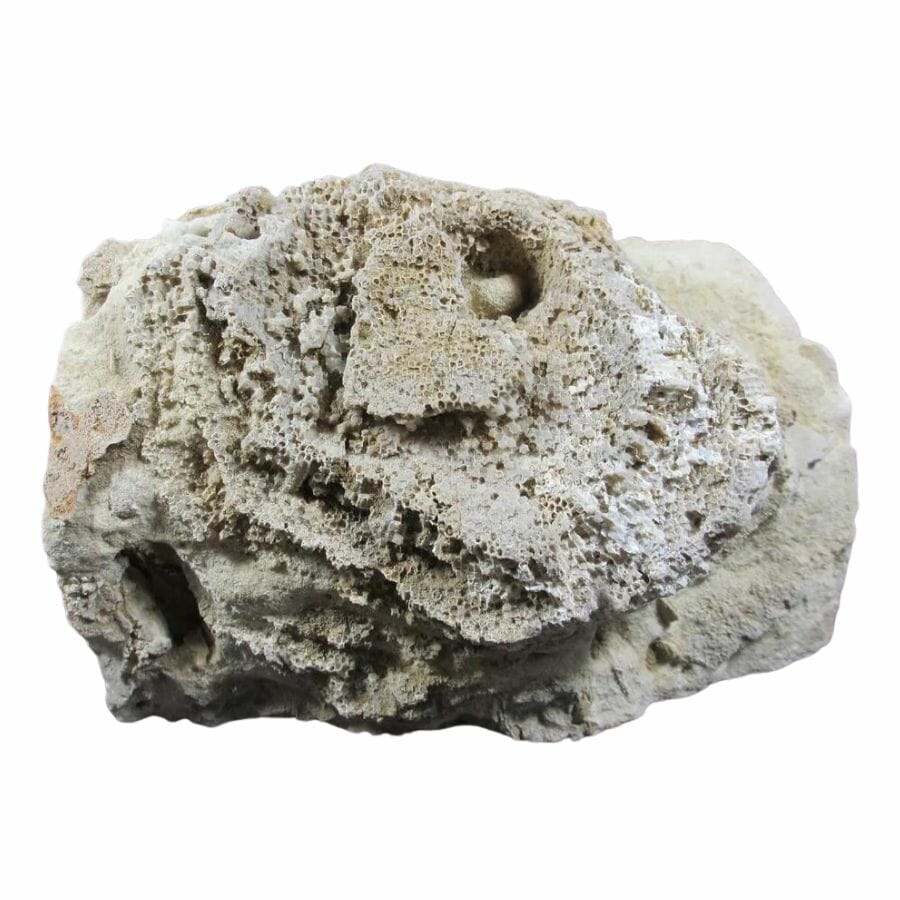
There’s a lot to learn about fossils found in Wisconsin. These are the answers to some of the most common questions about the state’s fossils.
Can you find megalodon teeth or shark teeth in Wisconsin?
While it’s exciting to think about discovering such a find, megalodon teeth are not typically found in Wisconsin.
The state was covered by shallow seas hundreds of millions of years ago, but these seas existed long before megalodons swam the Earth.
As for other shark teeth, while sharks did live in those early seas, their remains are not common fossils in Wisconsin. Instead, the state is more known for trilobites and other marine creatures from the Silurian and Ordovician periods.
If you’re keen on finding shark teeth, it might be best to explore areas closer to coastal regions where these creatures were more prevalent.
Is it illegal to collect fossils in Wisconsin?
There are rules to keep in mind if you want to go fossil hunting in Wisconsin. A lot of the land in the state is privately owned, so you’ll need permission from the landowner before searching for or collecting any fossils.
On public lands, like state parks and natural areas, collecting fossils is often not allowed to protect natural resources and preserve them for future generations. You can contact the Wisconsin Department of Natural Resources for more guidance.
Some specific sites may have their own set of rules, so it’s essential to check and understand those before you start. Penalties can be enforced for those who don’t follow the regulations.
If you’re keen on fossil hunting, joining a local rock and fossil club can be a great way to learn about the best legal places to look. Remember, while it’s exciting to find a fossil, it’s even more important to respect the land and the history it holds.
Can you find dinosaur bones in Wisconsin?
Wisconsin’s geologic record mostly comes from a time before the dinosaurs roamed the Earth. The rocks in this state are primarily from the Paleozoic Era, which predates the age of dinosaurs.
This means the chances of stumbling upon a dinosaur bone are very slim
Dinosaur bones in Wisconsin are, therefore, not a common find.
How do you identify the fossils that you find?
Take a close look at the shape and size of your find. Every fossil has unique features. Some might resemble shells, plants, or even animal footprints. Using a magnifying glass can help you see tiny details.
Next, consider the rock type you found the fossil in. Different fossils are found in different rocks. For example, limestone often has marine fossils like shells and corals.
Grab a good fossil guidebook or use online resources. These sources have pictures and descriptions to help you match your fossil to its name.
Once you think you’ve identified your fossil, try to learn more about it. This can help you understand the environment and creatures from millions of years ago. Remember, fossil hunting is a journey of discovery, so enjoy every step!
Our Favorite Places To Buy Fossils In Wisconsin

Wisconsin is home to some fantastic shops where you can find and buy unique fossils. These stores offer a mix of local discoveries and treasures from around the world.
- Mystic Moraine Minerals – 500 W Milwaukee St, Janesville, WI 53548
- Steven’s Rocks & Gifts – 134 E Main St, Marshall, WI 53559
- The Gem Shop, Inc. – W64N723 Washington Ave, Cedarburg, WI 53012
- Mystical Earth Gallery – 220 Main St, Menasha, WI 54952
- Door County Rock and Gem – 10421 Water St, Sister Bay, WI 54234 and Main St, Fish Creek, WI 54212

